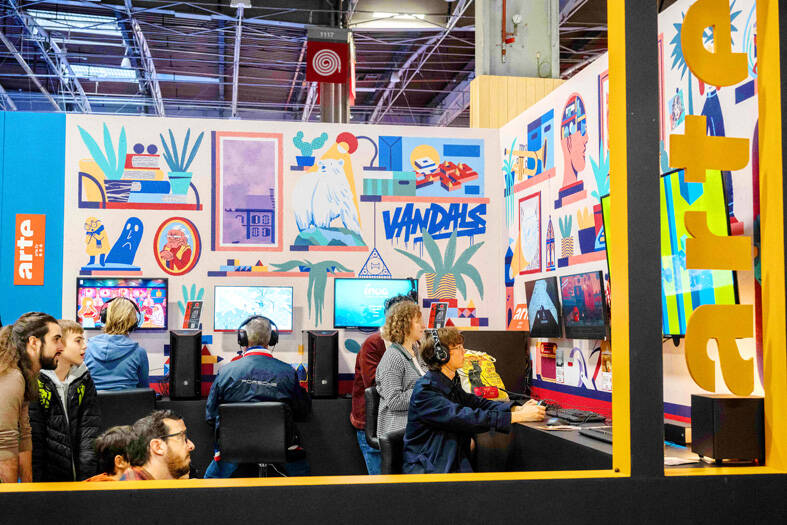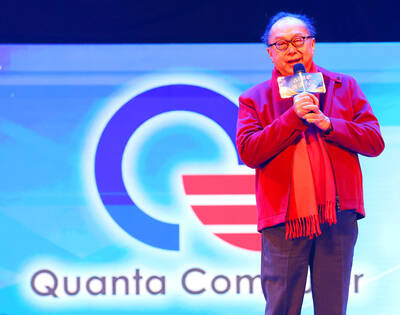French-German TV channel Arte is best known for covering cultural events and producing sophisticated dramas and documentaries, but over the past decade it has also been building a reputation in an entirely different arena: video games.
As with its TV programming, the publicly funded channel’s video games reflect its focus on culture and liberal causes — from an adaptation of a story by French author Boris Vian to an adventure game where the main character is a Syrian refugee.
“It’s a way of showing our editorial line to an audience which plays video games but doesn’t necessarily watch TV or consume documentaries,” Arte digital projects chief Adrien Larouzee said.

Photo: AFP
Arte has been in the gaming business for a decade, carving out a niche in “human scale” titles.
“We don’t work on blockbusters,” Larouzee said on the sidelines of Paris Games Week, France’s biggest video game trade show, where it has a stall alongside giants of the industry such as Sony Group Corp, Nintendo Co and Ubisoft Entertainment SA.
Larouzee said Arte was far happier with the “audacity” and “innovation” that comes from working with smaller, independent studios.
“We have the luxury of not having to think solely in terms of market share or commercial success,” he said. “We look for projects that are most compatible with our editorial strategy and those that we are able to support financially, editorially and humanely.”
The channel, funded by TV licenses levied in France and Germany, is finding an audience.
Arte has 17 coproductions with independent studios under its belt, its games being lauded at specialist festivals and praised by users.
It all started in 2013 with Type:Rider, a platform and puzzle game where the player bounces through landscapes strewn with references to scripts from prehistoric cave paintings to pixel art.
Straight-up literary games have included Californium, where the player is plunged into the psychedelic inner world of the famously troubled sci-fi author Philip K. Dick as he struggles with a flagging career.
The literary theme continued with this year’s To Hell With the Ugly, a highly stylized adventure game set in a noirish Los Angeles, adapted from a Vian novel.
The game has already won awards and praise from critics, with specialist site Xboxygen highlighting its “singular artistic direction” and “masterful gameplay.”
Arte’s games do not shy away from political issues — 2017’s Bury Me, My Love depicts a Syrian woman’s journey to Europe through messages to her husband.
The firm has long been an innovator with new technologies. It was an early adopter of video-on-demand and its social media channels boast more than 18 million subscribers.
The channel has an overall digital budget of between 10 million and 15 million euros (US$10.7million and US$16.1million) a year.
Marianne Levy-Leblond, head of Arte’s digital production unit, said investments in individual video games range from 100,000 to 300,000 euros.
With that relatively small outlay, the channel’s executives are determined to keep exploring the possibilities technology can offer.
“Obviously we’re paying a lot of attention to the metaverse,” Levy-Leblond said.
As an example how virtual reality (VR) feeds into the channel’s output, the channel is producing Gloomy Eyes — The Game, an adaptation of an animation that won Best VR Film at the Annecy Festival in 2019.
Levy-Leblond said that the channel already had a strong track record with projects using immersive technologies and planns to push further into that space in coming years.

Intel Corp chief executive officer Lip-Bu Tan (陳立武) is expected to meet with Taiwanese suppliers next month in conjunction with the opening of the Computex Taipei trade show, supply chain sources said on Monday. The visit, the first for Tan to Taiwan since assuming his new post last month, would be aimed at enhancing Intel’s ties with suppliers in Taiwan as he attempts to help turn around the struggling US chipmaker, the sources said. Tan is to hold a banquet to celebrate Intel’s 40-year presence in Taiwan before Computex opens on May 20 and invite dozens of Taiwanese suppliers to exchange views

Application-specific integrated circuit designer Faraday Technology Corp (智原) yesterday said that although revenue this quarter would decline 30 percent from last quarter, it retained its full-year forecast of revenue growth of 100 percent. The company attributed the quarterly drop to a slowdown in customers’ production of chips using Faraday’s advanced packaging technology. The company is still confident about its revenue growth this year, given its strong “design-win” — or the projects it won to help customers design their chips, Faraday president Steve Wang (王國雍) told an online earnings conference. “The design-win this year is better than we expected. We believe we will win

Quanta Computer Inc (廣達) chairman Barry Lam (林百里) is expected to share his views about the artificial intelligence (AI) industry’s prospects during his speech at the company’s 37th anniversary ceremony, as AI servers have become a new growth engine for the equipment manufacturing service provider. Lam’s speech is much anticipated, as Quanta has risen as one of the world’s major AI server suppliers. The company reported a 30 percent year-on-year growth in consolidated revenue to NT$1.41 trillion (US$43.35 billion) last year, thanks to fast-growing demand for servers, especially those with AI capabilities. The company told investors in November last year that

Power supply and electronic components maker Delta Electronics Inc (台達電) yesterday said it plans to ship its new 1 megawatt charging systems for electric trucks and buses in the first half of next year at the earliest. The new charging piles, which deliver up to 1 megawatt of charging power, are designed for heavy-duty electric vehicles, and support a maximum current of 1,500 amperes and output of 1,250 volts, Delta said in a news release. “If everything goes smoothly, we could begin shipping those new charging systems as early as in the first half of next year,” a company official said. The new